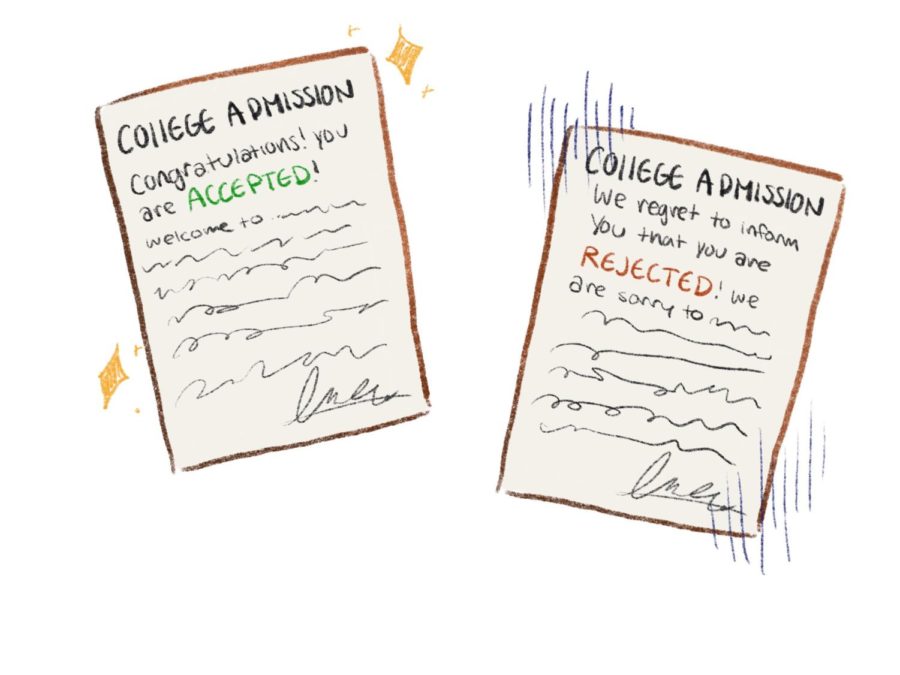Affirmative action crucial to ensure diversity of voices
Affirmative action serves as a mechanism to level the playing field of college applicants and prevent discrimination.
May 18, 2023
Since it was instituted in 1958, affirmative action has served as a vital policy that has helped thousands of students of color achieve their dreams of pursuing higher education. Ever since 1977, various judges have ruled in favor of affirmative action as a method to promote diversity in universities, dubbing it a “compelling governmental interest.” However, in 2014 the organization Students for Fair Admissions sued both Harvard and UNC, asking the Supreme Court to overrule 40 years of precedent supporting affirmative action. These ongoing cases, scheduled to reach a decision in June 2023, threaten to eliminate race as a factor in university admissions once and for all. Eliminating affirmative action does nothing to address the current widespread inequalities that plague higher education. Instead, it exacerbates them and endangers the success and livelihood of people of color (POC).
Critics of affirmative action often claim that they’re fighting for “racial equality” but ignore the obvious, overwhelming inequality in education that will ensue if affirmative action comes to an end. These critics attack affirmative action with the argument that the policy is inconsistent with principles of equality because it discriminates against White and Asian applicants. However, affirmative action is a necessary policy that simply attempts to level the playing field and promote diversity in higher education. In fact, recent studies have found that the supposed “Asian penalty” is caused by white advantages in college admissions, not affirmative action.
It’s no secret that wealth determines how likely one is to go to college. The Hechinger Report says that students from high-income families are eight times more likely to get bachelor’s degrees by the time they’re 24 than those from low-income families. Yet critics of affirmative action tend to leave out the fact that socioeconomic status is almost intrinsically linked to race, meaning that White and Asian students, being the wealthiest racial groups, have an inherent and unjust advantage when it comes to college admissions. Removing affirmative action has only one purpose and one outcome: the elimination of diversity in higher education through the exacerbation of unjust advantages held by most Asian and White students.
According to the Brookings Institution, the net worth of a typical White family is nearly 10 times greater than that of a black family. Even more, the National Institute of Health states that Asians have the highest median household income in the U.S. This means that most White and Asian students have greater access to academic and extracurricular resources that lead to the test scores, awards, and outstanding extracurriculars necessary for admission to top universities. One of the biggest reasons for this is that wealthier students go to better-funded schools with more, high-quality resources. NPR reports that the low-income Chicago Ridge district spent $9,794 per child in 2013, lower than the national average, while the affluent Rondout district spent $28,639 per child. Even more, NBC states that wealthy students are more likely to attend schools with AP classes and have access to tutors and standardized test preparation.
One of the biggest wealth and race-related disparities causing inequality in college admissions is that of standardized test scores. In a 2013 paper, “Race, Poverty and SAT Scores,” researchers Ezekiel J. Dixon-Roman and John J. Mcardle found that wealthy students earn higher SAT scores compared to their low-income peers. This means that unless all universities became test-optional, college admissions would remain inherently unequal—an issue that those against affirmative action have yet to acknowledge.
Another significant inequality that critics of affirmative action fail to address is legacy admissions, which give preference to applicants who are related to alumni. This policy, created in the 1920s to minimize enrollment of Jewish students, is built upon the discrimination of minorities and perpetuates historical inequalities in education. Today, legacy admissions continue to give many White students an upper hand in college admissions and are entirely more unequal than affirmative action. Columbia University found that between 2014 and 2019, Harvard had a 33 percent acceptance rate for legacy students, more than five times its overall acceptance rate. NBC states that 70 percent of all legacy students are white. The National Bureau of Economic Research further states that 75 percent of White students admitted on the basis of parent donations, legacy, or athletic recruitment would have been rejected if they had applied without these benefits. In the end, if affirmative action is eliminated on the principle of equality, it only makes sense to eliminate legacy admissions as well.
The worst part about these lawsuits is that we already know exactly what is going to happen if affirmative action is eliminated – we have seen it before. The Atlantic states that after Michigan prohibited the consideration of race in admissions at public colleges and universities in 2006, the number of Black students at the University of Michigan decreased from 9 to 4 percent, and has not increased since. 4 percent is nowhere near diverse or equal, especially considering the fact that black students make up 37 percent of all applicants. Eliminating affirmative action has nothing to do with equality – this will only make the number of students from marginalized communities attending the nation’s top universities a rarity, making them less diverse than they already are.
Without affirmative action, true diversity and equality in higher education will never exist, harming all students in the long run. Diversity has been proven to create more open-minded, kinder, and well-rounded students. Even more, decades of research from organizations like the Education Trust and American University have shown that diversity enhances educational quality and promotes student success by improving cognitive skills and critical thinking. Less diverse universities will create a less diverse workforce, prohibiting the country from reaping the plethora of economic benefits of diversity. According to the University of Illinois, companies with the highest racial diversity experience 15 times more sales revenue and are 43% more likely to experience higher profits. Even more, a diverse workforce provides diverse perspectives and experiences that can help make our nation’s goods and services useful for all citizens, regardless of their background. At the end of the day, eliminating affirmative action and eradicating diversity doesn’t just harm minorities—it hurts everybody.
The sad truth is that our government and society have failed at creating a level playing field in which affirmative action is not a necessity. Even vital resources like scholarships are incredibly flawed. NPR states that minorities, despite making up a third of all applicants, are less likely to receive scholarships. White students receive 72 percent of all scholarships, while minority students only receive 28 percent. Data from the U.S. Department of Education shows that students in the highest income quartile are more likely to receive the largest merit-based institutional grants, taking away vital resources for low-income students. Even federal grants for “exceptional financial need” are not enough; students in the lowest income quartile still need an average of $14,000 per year even after grants from all sources (institutional, federal, state, private) are taken into account. When even the most basic methods of assistance are almost entirely given to the most fortunate, affirmative action is all the more necessary.
The unfortunate reality in the United States is that, more often than not, most children of color are born at an inherent disadvantage. Taking away the sliver of an opportunity that is affirmative action is at its core a racist action. Opponents of affirmative action may cling to principles of equality, but their refusal to fight against the inequalities in college admissions that harm non-white and non-Asian students reveals their true motivations. Instead, they fight to put an end to diversity and the dreams of millions of children of color. If they succeed, they will have failed the over 10 million innocent children of color living in poverty, victims of the evils of systemic racism and the economic marginalization of minorities that continue to plague our nation. They will have failed the plethora of judges, litigators and teachers that have spent decades fighting for diversity in education. Until economic disparities between races are adequately addressed, college admissions without affirmative action will remain inherently unequal, unethical, and disgraceful.



